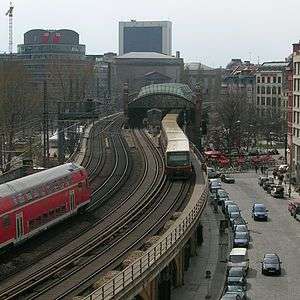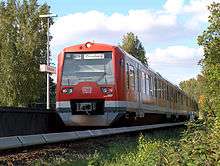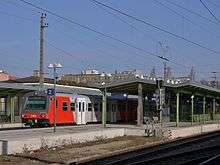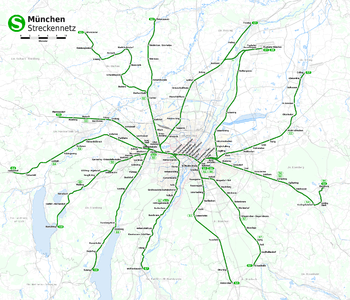S-train







The S-train is a type of hybrid urban and suburban railway. Some of the larger S-train systems provide service similar to rapid transit systems, while smaller ones often resemble commuter or even regional rail. They are especially common in Germany, where they are known as S-Bahn, which in the 1930s was an abbreviation of either Schnellbahn, Stadtbahn or Stadtschnellbahn, depending on the city, but they must not be confused with U-Stadtbahns.[1] Similar S-train systems exist also in Denmark, there known as S-tog, the Czech Republic as Esko, Switzerland and Austria also as S-Bahn, and northern Italy as Servizio ferroviario followed by either the word "metropolitano" (in Turin) or "surburbano" (in Milano).
Characteristics
There is no complete definition of an S-train system. S-trains are, where they exist, the most local type of railway stopping at all existing stations inside and around a city. They are slower than mainline railways but usually serve as fast crosstown services within the city. Most S-train systems are entirely built on older local railways, or in some cases parallel to an existing dual track railway. Most use exsisting local mainline railway trackage, but a few branches were built for S-trains.[2][3] S-trains typically use overhead lines or a third rail for traction power. In Hamburg the S-trains use both the latter methods, depending on which line is powered.[4]
In smaller S-train systems and suburban sections of larger ones S-trains typically share tracks other rail traffic with the Berlin S-Bahn, Hamburg S-Bahn and Copenhagen S-train being notable exceptions. Busy S-train corridors sometimes have sections of exclusive trackage of their own but parallel to mainline railways. A good example of this is the part of Berlin's S-Bahn, which is regarded as a tourist attraction [5] and have a special name, Berliner Stadtbahn.[6] However in more lightly used sections outside the city center, S-trains share tracks with other train types. The S-trains stop at all stations, while other mainline trains only stop at the largest stations (typically junction stations). S-trains are generally service the hinterland of a certain city, rather than connecting different cities, although in high population density areas a few exceptions from this exist. A good example of a such exception is the Rhine-Ruhr S-Bahn, which interconnects the cities, towns and suburbs of the Ruhr, the large urban agglomeration which contains cities like Dortmund, Essen, Wuppertal and Düsseldorf, not unlike the large net of regional trains which also serve the area. The S-Bahn Mitteldeutschland constitutes the main local railway system for Leipzig but also connects to Halle, where a few stations are located. The Rostock S-Bahn is an example of a smaller S-Bahn system.
Many of the larger S-train systems also have central sections that all the individual suburban branches feed into, creating high frequency corridors. In many cases, several lines serving separate suburban branches will converge into a central underground line in the city center with close stop spacing similar to metro systems. This gives a very high combined frequency of all the branches through city center area. For instance, on weekdays, the central section of the Copenhagen S-train has five services connecting to and from three suburban branches, which amounts to 30 trains in each direction.[7] Further out from the central parts of a city the individual services branch off into lines with distances between stations can exceed 5 km, similar to commuter rail. This allows the S-train to serve a dual transportation purpose: local transport within a city center and suburban transport between central boroughs of larger cities, and to suburbs. Frequencies very wildly between systems with short headways in the core sections of large networks to headways of over 20 minutes in remote sections of the network, late at night and/or on Sundays and in smaller systems. The rolling stock typically used in S-Trains reflect its hybrid purpose. The interior is designed for short journeys with provision for standing passengers but may have more space allocated to larger and more numerous seats. Integration with other local transport for ticketing, connectivity and easy interchange between lines or other system like metros is typical for S-trains. Where both S-train and metro exist, the number of interchange stations between the two systems is substantial with metro tickets being valid on S-trains, and vice versa.
Etymology
Germany, Austria and Switzerland
The name S-Bahn (S-train) is an abbreviation for the German "Stadtschnellbahn" (meaning "city rapid railway") and was introduced in December 1930 in Berlin. The name was introduced at the time of the reconstruction of the suburban commuter train tracks— the first section to be electrified was a section of the Berlin–Szczecin railway from Berlin Nordbahnhof to Bernau bei Berlin station in 1924, leading to the formation of the Berlin S-Bahn.[8]
The main line Berlin Stadtbahn (English: City railway of Berlin) was electrified with a 750 volt third rail in 1928 (some steam trains ran until 1929) and the circle line Berlin Ringbahn was electrified in 1929. The electrification continued on the radial suburban railway tracks along with changing the timetable of the train system into a rapid transit model with no more than 20 minutes headway per line where a number of lines overlapped on the main line. The system peaked during the 1936 Summer Olympics in Berlin to a train schedule below 2 minutes.[9]
The idea of heavy rail rapid transit was not unique to Berlin. Hamburg had an electric railway between the central station ("Hauptbahnhof") and Altona which opened in 1906 and in 1934 the system adopted the S-Bahn label from Berlin. The same year Copenhagen's S-tog opened its first line. Vienna had its Stadtbahn main line electrified in 1908 and also introduced the term Schnellbahn ("rapid railway") in 1954 for its planned commuter railway network (which started operations in 1962). The S-Bahn label was sometimes used as well, but the name was only switched to S-Bahn Wien in 2005. As for Munich, a first breaking ground for an S-train-like rapid transport system running through tunnels in downtown areas, bundling and interconnecting existing suburban and local railways, and the construction of what is now Goetheplatz underground station (line U6) took place in 1938, executed by the Nazi government of Adolf Hitler. Plans and construction work came to a halt early in World War II and were not pursued in its aftermath. The nowadays very extensive S-Bahn-System, and the first two U-Bahn lines, began to operate prior to the 1972 Summer Olympics.
The term S-Bahn was until March 14, 2012 a registered wordmark of Deutsche Bahn, where at the request of a transportation association the Federal Patent Court of Germany ordered the wordmark to be removed from the records of the German Patent and Trade Mark Office.[10] Prior to the said event Deutsche Bahn collected a royalty of 0.4 cents per train kilometer for the usage of the said term.
Denmark
The "S" stood for "station". Just before the opening of the first line in Copenhagen the newspaper Politiken on 17 February 1934 held a competition about the name, which in Danish became known as Den elektriske enquete or "The electrical survey" (as the Copenhagen S-trains would become the first electrical railways in Denmark). But since an "S" already was put up at all the stations, weeks before the survey, the result became S-tog which means "S-train".[11] This was also just a few years after the S-trains had opened in Berlin and Hamburg.
History
Germany
Early steam services
In 1882, the growing number of steam-powered trains around Berlin prompted the Prussian State Railway to construct separate rail tracks for suburban traffic. The Berliner Stadtbahn connected Berlin's eight intercity rail stations which were spread throughout the city (all but the Stettiner Bahnhof which today is a pure S-train station known as Berlin Nordbahnhof; as the city Stettin today is Polish city Szczecin). A lower rate for the newly founded Berliner Stadt-, Ring- und Vorortbahn (Berlin City, Circular and Suburban Rail) was introduced on 1 October 1891. This rate and the growing succession of trains made the short-distance service stand out from other railways.
The second suburban railway was the Hamburg-Altonaer Stadt- und Vorortbahn connecting Hamburg with Altona and Blankenese. The Altona office of the Prussian State Railway established the electric powered railway in 1906.[12]
Electricity

The beginning of the 20th century saw the first electric trains, which in Germany operated at 15,000 V on overhead lines. The Berliner Stadt-, Ring- und Vorortbahn instead implemented direct current multiple units running on 750 V from a third rail. In 1924, the first electrified route went into service. The third rail was chosen because it made both the modifications of the rail tracks (especially in tunnels and under bridges) and the side-by-side use of electric and steam trains easier.[12]
To set it apart from the subterranean U-Bahn, the term S-Bahn replaced Stadt-, Ring- und Vorortbahn in 1930.
The Hamburg service had established an alternating current line in 1907 with the use of multiple units with slam doors. In 1940 a new system with 1200 V DC third rail and modern electric multiple units with sliding doors was integrated on this line (on the same tracks). The old system with overhead wire remains up to 1955. The other lines of the network still used steam and later Diesel power. In 1934, the Hamburg-Altonaer Stadt- und Vorortbahn was renamed as S-Bahn.
List of S-train networks
Austria
The oldest S-Bahn system in Austria is the Vienna S-Bahn, which predominantly uses intercity rails. It was established in 1962, although it was usually referred to as Schnellbahn until 2005. The white "S" on a blue circle used as the logo reflects the layout of the central railway lines. The rolling stock was blue for a long time, reflecting the logo colour, but red is used uniformly for nearly all local traffic today.
In 2004, the Salzburg S-Bahn went into service as the first Euroregion S-Bahn, crossing the border to the neighbouring towns of Freilassing and Berchtesgaden in Bavaria. The network is served by three corporations: the Austrian Federal Railways (ÖBB), the Salzburger Lokalbahn (SLB) and the Berchtesgadener Land Bahn (BLB). The Salzburg S-Bahn logo is a white S on a light blue circle.
The S-Bahn network in Graz is in its first phase. Currently the following lines are active: S1, S11, S5, S51, S6, S7 while S3, S31 and S32 are still under construction. Extension works shall be finished by 2012.
On December 9, 2007 the Tyrol S-Bahn opened, running from Hall in Tirol in the east to Innsbruck Hauptbahnhof and Telfs in the west and from Innsbruck to Steinach am Brenner. Class 4024 EMUs are used as rolling stock on this network.
The regional train line in the Vorarlberg Rhine Valley is a nominal S-Bahn. The S-Bahn network in Linz is under discussion.
Belgium
The suburban railways of Brussels are currently being integrated into the Brussels Regional Express Network (French: Réseau Express Régional Bruxellois, RER; Dutch: Gewestelijk ExpresNet, GEN), which is identified by the letter S across both languages.[13]
Czech Republic
In the Czech Republic, integrated commuter rail systems exist in Prague and Moravian-Silesian Region. Both systems are called Esko, which is how S letter is usually called in Czech. Esko Prague has been operating since December 9, 2007 as a part of the Prague Integrated Transport system. Esko Moravian-Silesian Region began operating on 14 December 2008 as a part of the ODIS Integrated Transport system serving the Moravian-Silesian Region. Both systems are primarily operated by České dráhy. Several shorter lines are operated by other companies.
Denmark
Copenhagen S-train connects the city centre, other inner and outer boroughs and suburbs with each other. The average distance between stations is 2.0 km, shorter in the city core and inner boroughs, longer at the end of lines that serve suburbs. Of the 85 stations, 32 are located within the central parts of the city. Some stations are located around 40 km from Copenhagen city centre. For this reason the fares vary depending on distances. One-day-passes which tourist buy are valid only in the most central parts of the S-train system. The Copenhagen Metro opened in 2002 as a complement to the already existing S-train system. Copenhagen's S-train system is the only one in the country. Outside Denmark, in cities where both exist, is it far from unusual that a metro system later has been complemented with S-trains. The branch towards Køge (the southernmost S-train station in Copenhagen's S-network) has a rather unique history, as it was built in the 1970s where no previous railway ever had existed. At least north of the Alps, most S-train tracks have been taken over from other local trains during electrifications and other modernisations.
Germany
The trains of the Berlin and Hamburg S-Bahn systems ran on separate tracks from the beginning. When other cities started implementing their systems in the 1960s, they mostly had to use the existing intercity rail tracks, and they still use more or less much such tracks.
The central intercity stations of Frankfurt, Munich and Stuttgart are terminal stations, so all three cities have monocentric S-Bahn networks. The S-Bahn trains use a tunnel under the central station and the city centre.
The high number of large cities in the Ruhr area promotes a polycentric network connecting all cities and suburbs. The S-Bahn Rhein-Ruhr, as it is called, features few tunnels, and its routes are longer than those of other networks. The Ruhr S-Bahn is the only S-Bahn network to be run by more than one corporation in Germany, and the Salzburg S-Bahn holds a similar distinction in Austria. Most Swiss S-Bahn systems are multi-corporation networks, however.
Most German S-Bahn networks have a unique ticket system, separated from the Deutsche Bahn rates, instead connected to the city ticket system. The S-Bahn of Hanover, however, operates under five different rates due to its large expanse.
One S-Bahn system is no longer in operation; it is the Erfurt S-Bahn which operated from 1976 until 1993 and was an 8.6 km (5.3 mi) single-line system which consisted of four stations from Erfurt Central Station to Erfurt Berliner Straße station in the then newly built northern suburbs of Erfurt.[14]
Future S-Bahn systems are the Danube-Iller S-Bahn which is expected to enter service in December 2013,[15] and the Augsburg S-Bahn which was originally planned to go into service in 2011 but has now been delayed to 2015.[16] The S-Bahn system in Lübeck is under discussion (Network plan).
The Stadtbahn Karlsruhe (a tram-train network) uses the green "S" logo, but does not refer to itself as S-Bahn. The blue U-Bahn logo is not used either, due to the lack of subterranean lines.
Despite their names, the Breisgau S-Bahn (Freiburg) and the Ortenau S-Bahn (Offenburg) are both Regionalbahn services.
The following networks are currently in operation:
- Berlin S-Bahn
- Bremen S-Bahn
- Dresden S-Bahn
- Hamburg S-Bahn
- Hanover S-Bahn
- Magdeburg S-Bahn
- S-Bahn Mitteldeutschland (previously known as Leipzig-Halle S-Bahn)
- Munich S-Bahn
- Nuremberg S-Bahn
- Rhine-Main S-Bahn (Frankfurt / Mainz / Offenbach / Wiesbaden)
- Rhine-Neckar S-Bahn (Ludwigshafen / Mannheim / Heidelberg / Karlsruhe)
- Rhine-Ruhr S-Bahn (Ruhr Area / Cologne)
- Rostock S-Bahn
- Stuttgart S-Bahn (Line S60 is a single track which also is used by freight trains)
Italy
Suburban railways service in the northern parts of Italy are operated by regional train companies such as Trenord in Lombardy in joint venture with metropolitan transit authority like GTT in Turin, Piedmont. With ten lines Milan suburban railway service is the biggest one.
Operating services in the country are:
- Milan suburban railway service, operated by Trenord and ATM.
- Turin metropolitan railway service, operated by Ferrovie Regione Piemonte and GTT.
- Bologna Suburban railways service, operated by Ferrovie dell'Emilia Romagna.
- Brescia Suburban railways service, operated by Trenord.
Switzerland
S-Bahn is also used in German-speaking Switzerland. While French publications of those networks translate it as RER, the line numbers are still prefixed with an S (e.g. S2).
The oldest network in Switzerland is the Bern S-Bahn, established in stages from 1974 and has adopted the term S-Bahn since 1995. It is also the only one in Switzerland to use a coloured "S" logo. In 1990, the Zürich S-Bahn, which covers the largest area, went into service. S-Bahn services were set up in the course of the Bahn 2000 initiative in Central Switzerland (a collaborative network of S-Bahn Luzern and Stadtbahn Zug), St. Gallen (S-Bahn St. Gallen) and Ticino (Rete celere del Canton Ticino).
The Regio S-Bahn Basel services the whole Euroregion "Regio TriRhena", thus providing cross-border transportation into both France and Germany. A tunnel connecting Basel's two large intercity stations (Basel Badischer Bahnhof and Basel SBB) is planned as Herzstück Regio-S-Bahn Basel (lit. heart-piece Regio-S-Bahn Basel).
The Réseau Express Vaudois of Lausanne will be incorporated in the planned S-Bahn Léman (called RER Léman in French-speaking areas) around Lake Geneva (fr. Lac Léman). Geneva will be the second centre of this network. Transborder networks for the Lake Constance-adjacent German states Baden-Württemberg and Bavaria, the Austrian state Vorarlberg and the Swiss cantons St. Gallen and Thurgau are under discussion. Possible names are Bodensee-S-Bahn and Alpenrhein-Bahn.
See also
- Commuter rail
- U-Bahn
- Urban rail transit
- Train categories in Europe
- List of suburban and commuter rail systems
References
- ↑ See example of this for Stuttgart ("Warum Stuttgart trotz U keine U-Bahn hat" ; literal translation: "Why does Stuttgart despite the U lack a U-Bahn (=Metro/Underground/Subway)
- ↑ An example of this is the Køgebugt or Køge-Bay railway at Copenhagen, built 1971 to 1983
- ↑ S-train tunnel at Hamburg between Central Station and Altona 1967-1979
- ↑ http://s-bahn-galerie.de/S_Bahn_Hamburg/Geschichte_HH.htm
- ↑ http://www.stadtschnellbahn-berlin.de/strecken/01/
- ↑ same
- ↑ From Dybbølsbro to Svanemøllen or other way around (weekdays to the left) schematical map PDF at lines A,B,C,E & H. Time tables at PDF
- ↑ http://www.stadtschnellbahn-berlin.de (in German)
- ↑ http://www.stadtschnellbahn-berlin.de (in German); chose "Geschichte" (History)
- ↑ Beschluss Bundespatentgericht vom 14. März 2012. Retrieved April 14, 2013.
- ↑ John Poulsen: S-bane 1934-2009 side 47
- 1 2 See picture of Berliner Stadtbahn by Hackescher Markt S-train station, the third rail is clearly seen between the two S-Train tracks. Original name of that station was "Börse", or "the Stock Market" (which now is located in Frankfurt am Main)
- ↑ Alan Hope (15 September 2015). "NMBS releases details of S-train express network". Flanders Today.
- ↑ de:S-Bahn Erfurt
- ↑ de:Regio-S-Bahn Donau-Iller
- ↑ de:S-Bahn Augsburg
External links
-
 Media related to S-train at Wikimedia Commons
Media related to S-train at Wikimedia Commons






